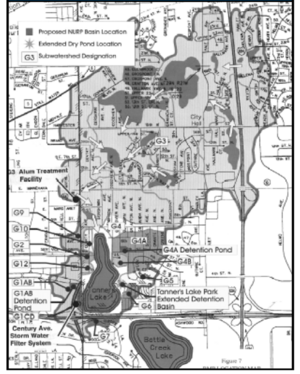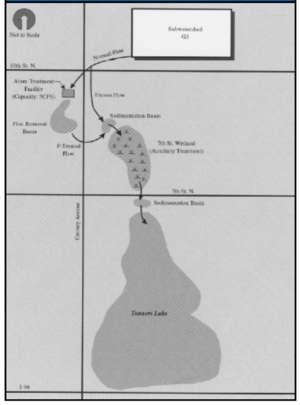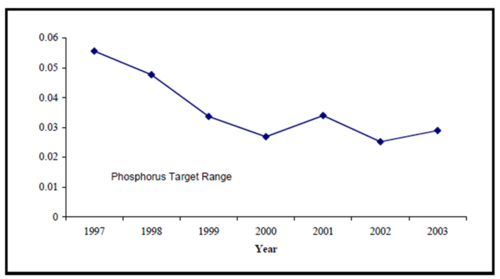
Tanners Lake - alum injection for phosphorus removal
Tanners Lake is located approximately 5 miles east of downtown St. Paul and suffers from common problems associated with urbanization of a lake’s watershed: snowmelt and stormwater runoff quantities to the lake have increased; water entering the lake carries nutrients and debris from storm sewers, highways, and parking lots from the surrounding watershed; and algal blooms and the abundance of aquatic vegetation have increased.
Project summary
- Location: Maplewood
- Landscape Setting: Suburban
- Drainage area: 1,954 acres
- Treatment area: 1 acre
- Project implementation: 1997
- Project cost: $663,000
- More information: Ramsey-Washington Metro Watershed District
Background
Ramsey-Washington Metro Watershed District (RWMWD) has attempted to address the water quality problems of Tanners Lake through District programs and enforcement of policies. In 1987, the District completed a wetland enhancement project immediately upstream from Tanners Lake to treat runoff waters from a large northern subwatershed (G3). However, water quality problems persisted in Tanners Lake despite these efforts. In 1988 the District received a Clean Lakes Program Phase I Diagnostic Study grant to evaluate the lake’s problems and determine feasible lake improvement measures. In 1989, a year-long water quality monitoring program of the lake and its inflows and outflows characterized the current lake water quality. Summer water quality parameters including total phosphorus and chlorophyll concentrations and Secchi transparencies indicated that the lake was eutrophic. mesotrophic status is considered a feasible goal, so it was clear that efforts to improve the lake water quality must focus on reducing the phosphorus load to the lake. Analyses of the lake’s inflows and outflows showed that the greatest source of phosphorus for Tanners Lake subwatershed G3, which enters the lake via a small stream on the north end.
Water-quality goals for Tanners Lake were established to meet the local desire for water quality improvement and to underscore the local desire for water quality management to improve the water quality of Tanners Lake so that it is consistently suitable for all types of uses. Swimming was the most sensitive recreational use of the lake and complaints of lake users centered on the problem of algal proliferation. Therefore, a reduction of the algal population in the lake was considered a primary goal.
Implementation
The District examined assumptions, effectiveness and costs of various options available to reach the established water quality goals. A variety of best management practices were identified to help achieve or exceed these goals, including
- public education;
- street sweeping;
- wet detention ponds;
- extended dry ponds;
- enhancement of existing wetlands;
- chemical treatment of stormwater; and
- metalimnetic aeration.
Fifteen separate options were identified and evaluated to estimate the range of costs for each option, estimate the removal of nutrients and other pollutants from stormwater, and estimate the resulting Secchi disc transparency achieved by implementing each option. Based upon the cost effectiveness analysis, the RWMWD Board of Managers selected an option that included the construction of two detention ponds in subwatersheds G1-AB and G4-A, an extended dry pond in subwatershed G5, and an alum treatment facility, in addition to an education and monitoring campaign.
Although use of alum treatment for water treatment and purification is not a new technology, its application to stormwater management is still a developing technology. The RWMWD application has several unique features: its design to address treatment of base stream flows, storm event flows, and seasonal changes in stormwater temperature and pH; its off-line system design; its thorough bench testing to address dosing for optimal phosphorus removal under various conditions; and, its design to comply with specific dissolved and total aluminum discharge standards. The alum treatment facility was installed to treat inflow from Subwatershed G3 at a location is immediately upstream from the wetland treatment facility. The facility injects the phosphorus-binding chemical, alum, in flow proportional quantities to strip the lake inflow of approximately 90 percent of its phosphorus load. The analysis of storm flow rates during the 1989 diagnostic study indicated that 85% of all the stream flows from subwatershed G3 were less than 5 cubic feet per second (cfs). All flows less than or equal to 5 cfs are diverted to the alum treatment system, and any flows greater than 5 cfs by-pass the diversion structure and flow directly to the wetland treatment system. A settling basin below the injection point was constructed to provide additional removal of the alum floc generated by the treatment process. The treatment facility design (i.e., off-line and treating only flows less than or equal to 5 cfs) will ensure that treated water has adequate settling time to remove all the alum floc before leaving the basin. The design also prevents basin scouring, which could dislodge settled alum floc. Thus, none of the alum floc will be allowed to enter the lake.
Costs
The facility is managed by District staff. Operations costs include staff time, alum supplies, routine equipment maintenance, utility charges (phone, electric water), permitting costs, and monitoring. Pond maintenance will also be annualized when a routine management plan is developed. Current annual operation costs are estimated at $30,000 (not including pond maintenance).
Results
The Alum Treatment Facility has been extremely effective at reducing phosphorus loading to Tanners Lake. Figures below show the reductions achieved in past years.
These reductions fluctuate annually depending on climatic conditions (primarily flow rainfall volumes and intensities). Fluctuations have also resulted from changes in dosing rates and operational changes to the plant to improve efficiency and flock formation. Due to the treatment of this large northern subwatershed by the alum facility, the lake has achieved and exceeded our goals for phosphorus and secchi disc readings:
The operation of the Treatment Facility has led to a 47 percent Total Phosphorus load reduction to Tanners Lake, in an average year.
Tanners Lake phosphorus: average summer phosphorus has declined from 0.055 milligrams per liter in 1997 to 0.025 milligrams per liter in 2002
Tanners Lake response: Trend of increased clarity and reduced algal growth since 2000.
Future actions
The RWMWD has been continuously monitoring the facility since its completion in 1997. Under the permit issued by the MPCA and the Minnesota DNR, the facility is monitored for inflow volume, inflow and outflow phosphorus and aluminum, and injected alum volumes. This data had been studied and used to improve treatment methods, alum dosage, and plant operations.
The RWMWD has made application and expects to receive its second five-year operations permit from the MPCA in 2005. This permit is expected to require continued monitoring of flows, alum injection volumes, pH levels, inflow and outflow dissolved and total aluminum levels, and inflow and outflow phosphorus. Annual reports will be provided to the MPCA.
An ongoing maintenance issue is the accumulation of alum flock in the facility settling pond. Accumulated flock was removed in the winter of 2003 to 2004. At that time the suspended flock had filled more than half of the pond volume and was impacting treatment effectiveness and increasing outflow aluminum levels. A flock management plan is being developed to annually remove accumulated flock from the pond bottom.




